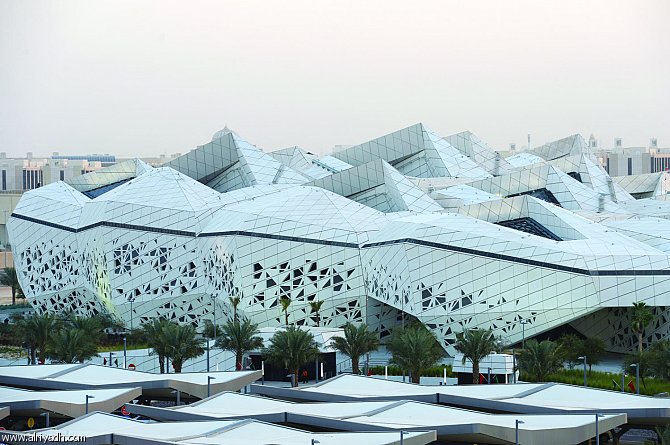The King Abdullah Petroleum Studies and Research Centre, also known as KAPSARC, claims to be an extremely futuristic structure, which continuously expands its crystal shape within the desert. The centre is designed to give an illusion that a white oasis descended on land directly from the sky it is inspired by the nature of a fresh leaf, which catches the sun and flourishes.
The shape of the spaces, which alternates between colours, closed and modern, particularly conceived to serve the purpose of studying and researching, but also resting and meeting people in an inspiring environment. KAPSARC, launched in 2009, is a non-profit institution focused on finding solutions for the most effective and productive use of energy to enable economic and social progress in the region and across the globe. The research areas include
global energy markets and economics, energy efficiency and productivity, energy and environmental technologies, and carbon management relevant to a country such as Saudi Arabia whose activities have always been linked to extractions.
However, its work aims at improving the economies of many other countries, such as China, India, and East Africa.
Additionally, the centre employs workers from 15 different nationalities, 40% of which are women. The centre includes two main areas, the first contains the IRA, while the second contains the research complex within five main buildings. A field of solar panels produces 20% of the electricity needs, with an area of 55,000 sqm and 18,000 units generating about 5,800 megawatt hours (MWh) of electrical energy annually.
KAPSARC stands as one of the biggest projects in Riyadh, with numerous companies wanting to be part of this major development. Mapei was chosen as the waterproofing supplier/manufacturer due to its expertise and competitive pricing. As a result of its old ties and joint projects history, the contractor, DEPA Saudi, was familiar and confident with Mapeis reliable systems and products quality that delivers constant results, claims the construction chemicals specialist. Mapei claims that the project was challenging, as the building needed to provide protection from the regions extreme heat and sun exposure. Materials needed to be placed in a manner to allow the smooth temperature
transition from one space to another, including all dry and wet areas.
Additionally, the building was aiming for all sustainable and energy efficient products, another reason the firm secured the project, turning their 530,000 sqm surface into an actual footprint area of 28,500 sqm. KAPSARC, with its massive area, is by far the largest petroleum research centre in the world. Mapei provided a complete waterproofing solution for the application of the wet areas and bathrooms, supplying products such as Mapeproof Swell and Mapegrout Thixotropic, primarily used to repair concrete, and Mapeband and Mapelastic AquaDefense for floor and wall waterproofing. The company used 23
The company used 23 tonnes of Mapelastic AquaDefense, in addition to 12,700 lm of Mapeband. Mapeproof Swell, a single component hydro-expansive paste, was applied to form flexible, waterproof seals in cracked and reinforced
concrete, sealing any crack in which water can seep through. It can also be used as a bonding product, for
various typed of joints in concrete walls. Then, Mapegrout Thixotropic, a shrinkage-compensated fibre-reinforced
mortar, was selected to repair deteriorated areas of concrete. Mapeband, an alkali-resistant rubber tape with felt, was selected to be used in combination with the waterproofing on the centres wet areas floors.
The solution was applied to corners between adjacent floors before applying the Mapelastic AquaDefense, ready-to-use, ultraquick drying, flexible liquid membrane for internal and external waterproofing applications. Mapelastic AquaDefense was selected to waterproof wet areas before laying the ceramic tile finishes. Built using the most advanced methods and technologies, KAPSARC achieved the first Leadership in Energy and Environmental Design (LEED) for Homes Gold Certification outside of North America for the centres residential facilities. The evaluation criteria was developed as part of the Honeywell Smart Building Score, which was launched in March 2016. The research evaluated 620 buildings across seven major Middle East cities, Abu Dhabi, Dammam/Dhahran, Doha, Dubai, Jeddah, Kuwait City, and Riyadh.
Key facts
The research centre was designed by world-renowned architect, Zaha Hadid, who passed away in 2016
Mapei provided a complete waterproofing solution for the application of the wet areas and bathrooms.




